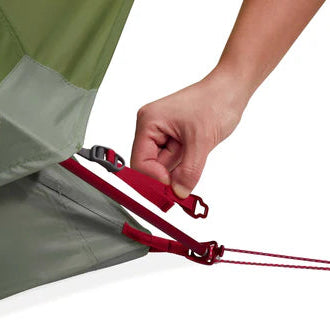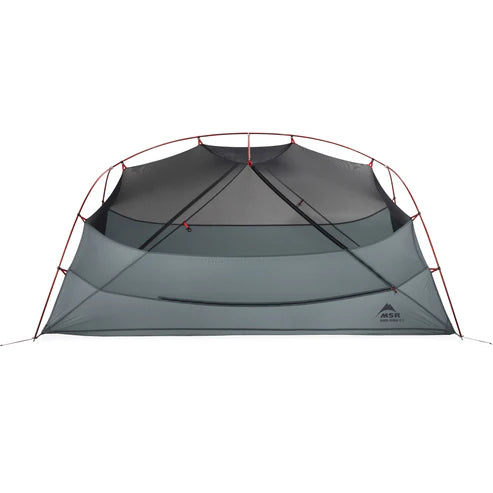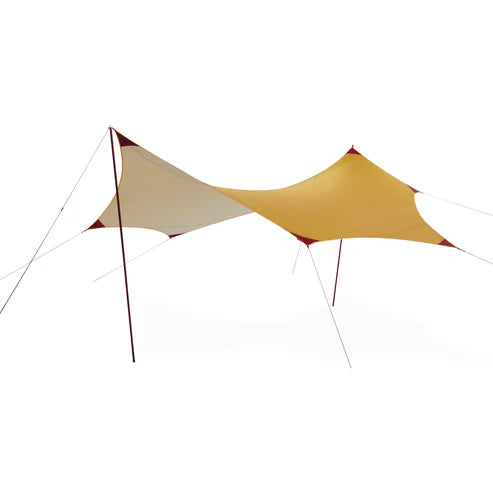1.What are some of the differences between three and four season tents?
Instead of thinking about these definitions based purely on seasonality, it helps to think in terms of what the tents are designed to handle.
At the most basic level, a 4-season (or winter) tent is designed to withstand extreme weather, holding up to fierce winds and heavy snow loads. A 3-season (or backpacking) tent is designed for lightweight performance and breathability. Therefore, deciding which is right for you depends on the environment and conditions in which you’ll be camping, rather than the season. Let’s take a closer look at their differences.
3-Season Tents
Spring treks, summer backpacking trips, fall campouts—most typical outdoor adventures call for a 3-season tent. 3-season tents are designed primarily to keep your pack light while still offering protection from bugs, wind and rain. Because of this, they’re often built of lighter fabrics and feature more mesh for breathability and airflow. They also typically use a double-wall construction (tent body + rainfly) for greater versatility.
3-season tents can range from featherweight models for fast-and-light backcountry travel to beefier and warmer models that are great for front-country camping. Most can handle pounding rain and light dustings of snow, but the lightest weight models are not great for extended periods of harsh weather.
4-Season Tents
The main job of a 4-season tent is to keep the occupant safe from extreme weather. Therefore, 4-season tents must be strong and sturdy. They feature rigid shapes and pole geometries that allow them to bear substantial snow loads and powerful winds. They also feature more durable fabrics as the snow, ice and rock of the alpine environments where they are most commonly used can be ruthlessly abrasive.
Because warmth is also important, 4-season tents greatly reduce or eliminate mesh on the tent body. Some feature mesh “windows” that can be zipped shut to seal out the elements. The addition of snow flaps around the tent’s perimeter on some models prevents snow and cold air from blowing inside.
All this fortification must be balanced with strategic ventilation options to manage moisture and prevent condensation build-up.
To accommodate adventurers in bulky winter gear, 4-season tents are generally a bit roomier than a typical backpacking tent. Many models also feature a large hooped vestibule to create the added space needed to store weeks’ worth of climbing gear. At the other end of the four-season spectrum, single-wall tents are built for the most extreme conditions in hard-to-get-to places. With only a single waterproof fabric wall between you and the elements, they sacrifice some breathability and space for an ultralight pack weight and small footprint that can be pitched on a hacked-out snow ledge without undue hassle at the end of a long day. They’re the to-go shelter for high camps and ultralight alpine objectives.
All winter tents come in bold, bright colors to make it easier to locate your tent in a storm.
For more information on this topic, check out our blog post.
2.What defines "waterproof" in a tent and what does the "mm" rating mean?
For tent, waterproof means that all external fabric has been coated with our exceptional polyurethane coatings and the seams are watertight out of the bag. "mm" refers to millimeters and is paired with a number to represent a standardized measurement of how waterproof a coating is. For instance, a 1500mm coating will withstand a 1500mm (5') column of water for more than one minute before a single drop might appear through the fabric. That's strong enough to prevent rain from leaking into a tent in a hurricane-force storm.
3.Is it necessary for me to register an account in order to buy an item?
Yes and this is made with your own convenience in mind. By creating (or using) an account during the purchasing process you will have 3
things made so much easier for yourself:
- Keeping track of your order's delivery status
- Changing or canceling the order
- Using your previous purchase history to become eligible for a Loyal Customer's discount
4.What do the letters D and T after the fabrics mean?
"D" stands for Denier. It's a numbering system for fibers, filaments and yarns, in which the lower numbers are lighter/finer and the higher numbers heavier/coarser. "T" stands for Thread Count – specifically the number of warp and fill threads in a square inch. The lower numbers represent a loosely woven fabric and the higher number a tightly woven fabric. These two numbers together help indicate the strength and feel of a piece of fabric.
5.What's the best way to clean my tent?
Cleaning your tent is not necessary unless it has an offensive odor or becomes heavily soiled. If heavily soiled, the pressure from a regular garden hose will remove most loose dirt. For more severe cleaning, set up your tent and hand wash it with warm water, a sponge and mild, non-detergent soap. Do not use dishwashing liquid, detergent, bleach, pre-soaking solutions, or spot removers. Rinse well. Dry your tent by pitching it or line-drying it. Never dry clean, machine- wash or machine-dry your tent. Any of these methods can remove all the waterproof coatings from the tent.
6.How do I prevent mildew?
One of the easiest ways to damage your tent is by not drying it as quickly as possible after it gets wet. Storing a wet tent for as little as 24 hours in warm weather is likely to start the process of mildew formation. Mildew can permanently damage the waterproof coatings by causing them to separate from the fabric, but mild to severe staining is more common. Mildew stains are permanent. They cannot be removed without potential harm to the fabric coatings and are not covered by warranty. Even when your tent appears to be dry after use, it is always best to assure it is completely dry before storing. Hang it outside or pile it loosely in your house for a few days, turning it inside and out to assure it has dried everywhere. Never machine dry your tent as the heat can melt the fabric.
7.How should I store my tent?
Never pack or store your tent if it is wet, damp or dirty. Although we use the best polyurethane waterproofing available, prolonged exposure to moisture causes hydrolysis which, in turn, causes the waterproof layer to break down, becoming soft, sticky and no longer waterproof. Storing a wet tent for as little as 24 hours in warm weather is also likely to start the process of mildew forming on the fabric. Mildew will cause your tent to stain, smell and will also lead to the premature breakdown of the waterproof coating. Mildew and moisture damage are not covered under the Limited Warranty.For long-term storage, keep your tent in a dry and cool area, out of direct sunlight. Store it outside of its stuff sack, as you would a sleeping bag, in a breathable, over-sized cotton or mesh duffel for protection. On the cheap, an old pillowcase is ideal.
8.How long will it take for my order to arrive?
Delivery times can vary depending on the shipping method selected in checkout and the destination of your package. If you selected our free shipping option, please note that it can take up to 10-20 business days to arrive. Faster shipping options may be available during checkout. Also, please be aware that weather, shipping holidays, peak shipping seasons and incorrect billing information can delay the shipment of your order.





